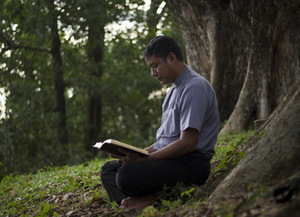18 Sep Peace-making in Myanmar
Written by Terence Lee
“Before that conflict, when we were young, I think every Muslim could visit any family of any religion. We had many Muslim friends when we were young, but in this age, we are not even allowed to visit their homes.”
Patrick is referring to the widespread rioting and clashes between Rakhine Buddhists and Muslims in 2012. Sporadic clashes between the Rakhine Buddhists and Rohingya Muslims had been that way for years, but in 2012 this came to head with widespread rioting leading to over 2,500 houses being razed, 90,000 people displaced and approximately 100 fatalities.
Myanmar has a long history of communal and religious mistrust, this occasionally leads to outbreaks of violence and clashes. Though the government has previously declared a state of emergency and imposed night time curfews, they have been criticised for being unable to prevent these clashes from happening.
As part of the Myanmar Council Of Churches (MCC), Patrick is heavily involved in the interfaith dialogue programme based out of Yangon. His aim: to reduce religious tension among religions.
“[We] are like mediators in terms of the dialogue programme and we are also the negotiators. We try to negotiate between this religion [Buddhism] and this religion [Islam].”
Each year, Patrick and the MCC team choose an existential topic and bring together leaders and influencers from the three major religions in Myanmar – Islam, Buddhism and Bahá’í. Over the course of two days, they would explore their religion’s point of view on that topic and at the same time come to a deeper understanding of how other religions process it.
Last year the theme of the gathering was “Kruna” a Burmese word that translates loosely to – reconciliation, loving kindness, or love something and bring about forgiveness.
Through this process of coming together, talking and engaging in each other’s beliefs, Patrick hopes to begin the process of breaking down barriers, correcting caricatures and enabling healing and reconciliation between the major faith groups of Myanmar.
Nevertheless, Patrick recognises that what he faces is no easy task. Christianity itself is viewed in a suspicious light. Many Buddhists see it as a foreign religion, a direct challenge to the Burmese way and to them, “Buddhism is for Burmese people. Authentic Burmese must be Buddhist. This is not only a religious issue, but a racial issue.”
Invitations to the Muslim community isn’t entirely straightforward either. Burmese Muslims are divided into three groups, and for reasons unknown these three groups do not get along, meaning invitations to one group can cause the other two groups to decline their attendance.
“It’s a very difficult situation and it’s not an easy task to come together. At least we need three to four months of preparation [each time]. Very hard. But we have to.” Affirms Patrick. “Myanmar is in a critical situation in terms of religious conflict. That’s why my focus is on the interfaith dialogue.”
Patrick sits across the small room from me, quiet, self-possessed, wearing a simple grey shirt and his clerical collar. As we speak at length of his home, his ministry and his country, he becomes more and more animated. His passion and determination is plain to see. It seems obvious that God has placed a heart and a calling for him to be a peacemaker in Myanmar.
There is no shortcut to peace and to reconciliation and Patrick is in for the long haul. Though it seems impossible for two people groups to come together and unite despite their differences, meeting individuals like Patrick gives me hope that, one day, that will be possible even in one of the most ethnically diverse countries in Asia.
Rev. Patrick recently participated in Asia Gateway Training 2017, a month-long course organised by AsiaCMS in collaboration with Seminari Theoloji Malaysia, the Anglican Diocese of West Malaysia, the Methodist Church in Malaysia, Operation Mobilisation, Overseas Missionary Fellowship, Interserve, and Serving in Mission.


